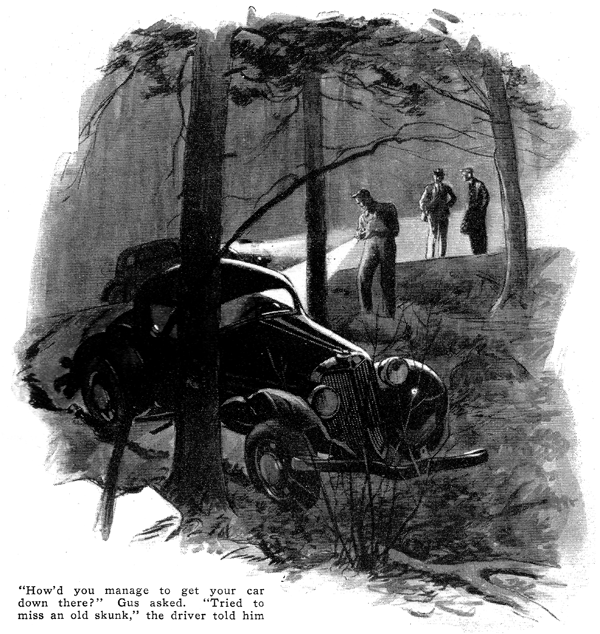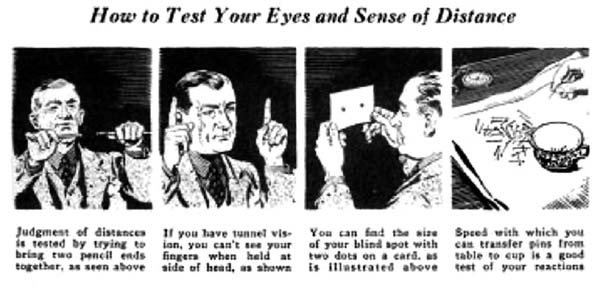July 1934
HOW IS YOUR DRIVING EYE?
by Martin Bunn

Gus Wilson nosed his car cautiously around a sharp bend in the pitch-black road.
Suddenly the figure of a man appeared in the bright glare of the headlights. He was standing in the center of the road waving his arms excitedly.
"What's this?" whispered Joe Clark as Gus jammed his foot on the brake, "a hold-up or an accident?"
As the car slid to a stop almost in front of the man, Gus poked his head through the open driver's window. "What's the trouble," he called.
"I'm in the ditch a few feet up the road," came the reply from the darkness. "Will you give me a hand?"
When Gus had maneuvered his car safely to the edge of the road he aimed the beam of his flashlight down the steep embankment that bordered the concrete. There, wedged between two trees, was the ditched car.
"Gosh," exclaimed Gus. "How'd you manage to get down there? Somebody force you off the road on that turn?"
"Yeah, an old skunk," replied the man sheepishly.
"A skunk," repeated Gus. "I've heard of skunks driving people out of a house before but never off of a road. What did you do, try to miss him?"
"Not only tried, but succeeded," the man groaned. "And here I am, I swerved to one side, but I guess I misjudged the distance and the next thing I know two trees loomed up in front of me."
"Can't do much about getting her up out of there tonight," said Gus regretfully. "My name's Gus Wilson and this is Joe Clark. We own a garage in the next town. Suppose we give you a lift in and then come out here first thing in the morning with our wrecker?"
"Fine idea," agreed the man. "My name's Townsend. I'm a salesman; use my car for traveling. I'll put up at a hotel for the night, make some calls in the morning, and drop around in the afternoon and see about the car."
When Townsend arrived at the Model Garage the next afternoon, Gus was already at work trying to iron some of the wrinkles out of the mudguards and hood.
"It's not as bad as it looked," Gus assured him. "No mechanical trouble and by chopping away some of the bark on those trees we managed to coax her out without ripping the body apart. You're lucky you went between those trees instead of into them."
"I can't understand how it all happened," moaned Townsend. "I couldn't have turned more than a couple of feet to miss that blamed pole cat and I've always been pretty good at judging distances on the road."
"Maybe your eyes aren't as good as you thought they were," suggested Gus as he shoved the service jack under the car and starting jacking it up.
"Never wore a pair of glasses in my life," boasted Townsend, "And I've always made out better than the average in eyeglass tests."
"Ever hear of blind spots?" inquired Gus between blows with a rubber fender hammer he was using.
Townsend shook his head.
"Well, everybody has them. It's one spot in each eye where you're actually blind. In most cases they're small and you don't notice them but sometimes they're large enough to cause trouble. We had a case here in town not so long ago. Tom Nevers, one of the best drivers I know, ran over a youngster. He argued that he never saw the girl and didn't know that he hit her until he felt the bump. Eyewitnesses claimed that the girl was standing there all the time waiting for a bus and that Nevers didn't seem to make any attempt to miss her.
"The whole thing was a puzzle until a doctor tested Never's eyes. It turned out that Tom had a blind spot that was large enough to blot out a whole car if it was standing in just the right place."
"Gosh, if you had a blind spot that large wouldn't you know it? Wouldn't you see a hole in everything you looked at?"
"Nope, they brought that out at the hearing. We've all got small blind spots, yet we don't see any holes in what we look at," replied Gus as he reached for a piece of paper that lay on the repair bench and fished a pencil out of his overalls pocket.
"Here, I'll show you how that doctor showed people how to look for their blind spots," he explained as he penciled two small black dots on the paper about three inches apart. "Take this paper in your right hand and hold it so that this dot at the left is in front of your right eye. That's it, only hold it at arm's length with the dots horizontal. Now, close your left eye and look at that left-hand dot. You see both dots?"
Townsend indicated that he could.
"O. K. Now move the paper toward your right eye slowly and keep on staring at that left dot. All of a sudden, you're going to see that right-hand dot disappear completely. That'll be your blind spot. Then as you move the paper still closer, it'll come back into view again."
"Well, I'll be hanged," exclaimed Townsend as he shifted the paper back and forth.
"With it held just about here, that right hand spot fades right out of the picture. Will it work with your left eye?"
"Sure, only instead of staring at the left hand dot you want to concentrate on the one at the right. Then the left dot does the disappearing act. By finding out how large the spot can be and still disappear, you can get a rough idea of how large your blind spot is."
As Gus continued his work on the car, Townsend amused himself, testing first one eye and then the other.
"Say," he said finally, "do you suppose I've got a large blind spot and that's what made me run off of the road last night?"
"Maybe, replied Gus. "I'm no eye doctor, but if you can blot out a large spot with that test, it might pay to find out."
"And that reminds me," continued Townsend, interested. "Sometime ago I heard something about tunnel vision. What's that?"
"Just another eye ailment that can cause a lot of auto accidents," explained Gus. "People with tunnel vision might just as well try to drive a car with a pair of blinders on. If your eyesight is normal, you can see what's going on alongside of you even though you're looking straight ahead. But if you've got tunnel vision, things on the side are just a blank. It's like looking at everything through a pipe or a tunnel."
"Can you do anything with black spots to check upon that tunnel trouble?" asked Townsend.
"According to the doctor who tested Never's eyes, one of the simplest ways is to hold your index fingers upright, back near each ear and then move them forward until you can see them even though you're staring straight ahead. A normal person will notice them as soon as they come opposite the eyes, but a person with tunnel vision won't even begin to see them until they're further out in front. To be a safe automobile driver you ought to be able to see an area in front of your eyes equal at least 110 degrees even when you're looking ahead.
"But then bum eyesight isn't the only thing that makes poor drivers," added Gus. "Nervousness and lack of judgment are close seconds. Have you ever tried to see just how well you really can judge distance? Here's a trick they used to try on student flyers that'll give you some idea. Just hold an ordinary pencil lightly in each hand about a foot from your eyes. Then, starting them horizontal and about two feet apart, see if you can bring the blunt ends together quickly the first time you try.
"And there's another little stunt you can do with ordinary pins to test your nerves. Take about fifty straight pins and pile them up on a newspaper. Then, with somebody timing you, see how long it takes to transfer those pins, one at a time, to a tin cup. If you call yourself a good driver, you shouldn't have to rush to move the whole fifty in less than a minute and a half."
"Holy smokes," put in Townsend. "If you had your way, only first class aviators would be driving cars."
"Oh, not as bad as all that," corrected Gus with a smile. "But you'll have to admit there are lots of people driving cars who shouldn't be. And the pity of it is, they drive too fast for their senses.
"Just the other day I was reading an article by a college professor. According to him, it takes the average person about a half a second to see danger and do something about it. Now, in a car going forty miles an hour, a half second is a long time. It can cover over thirty feet in that instant. That means, if you're hopping along a road at forty and suddenly see a car stalled across the road less than thirty feet ahead of you, you're bound to smash into it before you can even begin to do anything about it.
"It's speed that causes most bad accidents," warned Gus. "A harmless bump at twenty can be a smash-up at forty. There's a heap of power in a ton of metal hurled through the air at forty miles an hour."
"What's your idea of a good driver then, a slow poke?" inquired Townsend.
"No, not necessarily. My idea of a good driver is a man who knows himself and his car and isn't in a hurry to get no place to do nothing. When you meet a fellow that's courteous and takes good care of his car, you can bet he's a good driver.
"You can't be a good driver and pilot a pile of junk. Trouble is, people think so much of the power and speed of the buggy they're driving and not enough about how quickly it will stop and how well the headlights light up the road without bothering the other fellow. Tires, brakes, horn, lights, and rear view mirror are just as important as the motor."
"Gosh," called Joe Clark as Townsend maneuvered his car out of the driveway.
"Why the sermon on safety?" "You're a garage mechanic, not a policeman. You've probably got that guy so scared he'll have a hard time driving to the next town."
"Well, I'll bet he'll get there without climbing a couple of trees," returned Gus with a smile. "Being cautious and just a trifle scared never caused any fatal accidents. A swell-headed driver is one nut in a car that you can't fix with a wrench.
END
L. Osbone 2019
